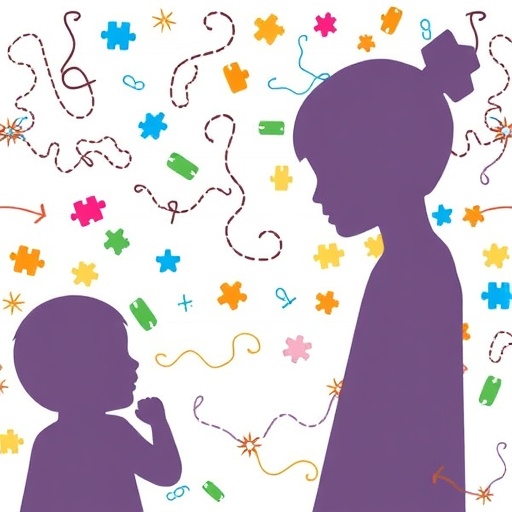Recent research has unveiled significant insights into the co-occurrence of epilepsy and autism spectrum disorder (ASD) within a large inpatient psychiatric sample, presenting critical implications for both clinical practice and the understanding of neurodevelopmental disorders. Conducted by an extensive team of researchers, this study highlights the prevalence of epilepsy among individuals with autism, shedding light on the intricate relationship between these two conditions. The findings indicate that a substantial number of patients hospitalized for mental health issues also exhibit symptoms of epilepsy, a phenomenon that underscores the importance of integrated care strategies.
The prevalence rates reported in this research are staggering, suggesting that the intersection of autism and epilepsy is more common than previously recognized. In clinical settings, where care is often fragmented between specialists and disciplines, this correlation may lead to missed opportunities for comprehensive treatment approaches. The researchers underscore that failing to address the neurological aspects of autism can exacerbate psychiatric symptoms, complicating the overall clinical picture and hindering effective management.
Furthermore, the study delves into the associated demographic and clinical factors that contribute to the likelihood of epilepsy in individuals with autism. For instance, age, gender, and intellectual disability seem to play pivotal roles in understanding this complex interaction. Through sophisticated statistical analyses, researchers can pinpoint these correlations, which are invaluable for developing targeted interventions tailored to specific subsets of the autism population.
The implications of having epilepsy coexist with autism are profound, affecting not only the individuals diagnosed but also their families and caregivers. Falling into the intersection of two neurological conditions, patients may face a myriad of challenges that significantly affect their quality of life. These include increased anxiety, management difficulties in educational settings, and the heightened need for support services. Therefore, recognizing the prevalence of epilepsy among autistic individuals is pivotal in advocating for more comprehensive support.
In terms of diagnostic processes, the findings of this research advocate for a more holistic approach. Clinicians are encouraged to remain vigilant for signs of epilepsy in their autistic patients, particularly those exhibiting cognitive challenges. The missed diagnosis of epilepsy can lead to unnecessary suffering, as well as potentially lost opportunities for neurological interventions that can improve patient outcomes. This study enhances the visibility of the need for comprehensive assessments during clinical evaluations.
Moreover, the study brings attention to the gap in research addressing the neurobiology underpinning the co-morbidity. While there is a growing body of evidence indicating shared pathophysiological mechanisms between autism and epilepsy, the specifics remain under-explored. Future research endeavors are paramount to elucidate the biological connections and inform treatment modalities that cater to both conditions. A deeper understanding of this relationship may pave the way for novel therapeutic strategies and pharmacological interventions that go beyond symptomatic management.
In addition to its implications for patient care, this study carries weight in guiding future legislative and funding efforts. The research community must recognize the urgency in addressing the unmet needs of individuals experiencing these dual diagnoses. By promoting awareness among policymakers and stakeholders, the hope is to facilitate increased funding for targeted research initiatives and support services that can significantly improve the lives of affected individuals and their families.
One of the most compelling aspects of this research is its potential to shift the narrative surrounding autism and epilepsy. Historically, epilepsy has been often overlooked in autism studies, with limited data regarding its prevalence and impact on autistic individuals. By placing epilepsy at the forefront, this research urges a paradigm shift towards appreciating the full spectrum of challenges faced by this population, endorsing the idea that comprehensive care must encompass all aspects of their health.
Furthermore, parental and caregiver education is an essential element that stems from this study. Understanding the prevalence of epilepsy, the associated risks, and the clinical indicators can empower families to seek proactive care for their loved ones. It also equips them with the knowledge to engage effectively with healthcare professionals, advocating for comprehensive assessments and suitable interventions.
The educational system also stands to benefit from the insights provided in this research. Teachers and school administrators can implement informed strategies when addressing the needs of students with autism and co-occurring epilepsy. By fostering supportive environments and training educational staff, positive outcomes can be achieved for students demanding extensive accommodations due to their dual diagnoses.
Interestingly, the study sparks conversations about the role of advocacy groups and communities in raising awareness about epilepsy in autism. Grassroots efforts can play a significant role in fostering camaraderie and providing platforms for sharing experiences, thereby diminishing the stigma associated with both conditions. The empowerment of communities to advocate for better resources can catalyze meaningful change.
In conclusion, this extensive investigation into the prevalence of epilepsy within an autism population is a landmark contribution to psychiatry and neurology. Its findings serve as a clarion call for clinicians, researchers, educators, and policymakers alike to recognize the interconnectedness of neurological and psychiatric disorders. As we move forward, the pursuit of integrated care models and continued research efforts will be crucial in advancing the understanding and treatment of autism and epilepsy, ultimately improving the lives of individuals navigating these complex challenges.
Identifying epilepsy in autism isn’t merely an academic exercise; it has real-world implications that can shape how care is delivered and prioritized within healthcare systems. As these trends gain momentum within the research community, the hope is that we can pivot toward a future where comprehensive care becomes the norm, ensuring that individuals with autism and epilepsy have access to the support and interventions they so critically need.
Subject of Research: Prevalence of epilepsy in individuals with autism spectrum disorder.
Article Title: Epilepsy in Autism: Prevalence and Associated Factors in a Large Inpatient Psychiatric Sample.
Article References:
Kielty, K., Luo, K., Siegel, M. et al. Epilepsy in Autism: Prevalence and Associated Factors in a Large Inpatient Psychiatric Sample.
J Autism Dev Disord (2025). https://doi.org/10.1007/s10803-025-07140-z
Image Credits: AI Generated
DOI: https://doi.org/10.1007/s10803-025-07140-z
Keywords: Autism, epilepsy, psychiatric sample, prevalence, comorbidity, neurodevelopmental disorders, integrated care, intervention strategies.




